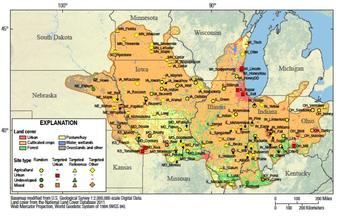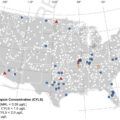[ad_1]
A common insecticide used in urban and agricultural areas, bifenthrin, is harmful to aquatic ecosystems at levels that were previously considered safe, according to a new study by the U.S. Geological Survey. The insecticide was measured in several streams in the Midwest at levels that caused harm to artificial aquatic ecosystems.
Bifenthrin is used to combat common household pests like ants and termites, to control mosquitos that could spread diseases like West Nile and Zika and on crops to kill aphids and other agricultural pests. About 1.2 million pounds of bifenthrin was used in the United States in 2013.
USGS scientists evaluated the effects of bifenthrin on natural communities of stream invertebrates, such as mayflies and midges, using artificial streams. Exposure to bifenthrin concentrations previously thought benign caused the insect populations to become less abundant and diverse, and caused an increase in algal growth as the larvae that feed on algae decreased. The insecticide also altered the timing of insect emergence from the larval state to become adults and complete their life cycle. The full study, reported in the scientific journal Environmental Science and Technology, is now available online.
There were obvious similarities between the data from the artificial stream test and data for 92 small streams in the Midwest studied by the USGS in 2013. The insect species that were most sensitive to bifenthrin in the artificial streams were less abundant or eliminated from Midwest streams with similar bifenthrin concentrations. About 40 percent of Midwest streams sampled had bifenthrin concentrations greater than levels that caused meaningful ecological change in the artificial stream study.
“The results of this experiment demonstrate that not only do aquatic insects die at concentrations of bifenthrin previously thought nontoxic, but that bifenthrin changes the way that stream ecosystems function,” said Travis Schmidt, a USGS ecologist and the lead scientist on the study. “Bifenthrin disrupts the ability of insects to control algal blooms, and disrupts the emergence of flying aquatic insects that are a food source for bats, birds and other animals in and around rivers.”
Parts of Ohio, Indiana, Illinois, Kentucky, Wisconsin, Minnesota, Iowa, Missouri, South Dakota, Nebraska, and Kansas were included in the study.
This study is the one of several regional stream-quality assessments by the USGS. Findings will provide the public and decision makers with information regarding which human and natural factors are the most critical in affecting stream quality. Regions studied include the Southeast (2014), the Pacific Northwest (2015), the Northeast (2016) and California (2017).
Support for this work was provided by the USGS National Water Quality Assessment Project (NAWQA).
[ad_2]
Source link
- Warmer water could cool Montana’s trout fishing economy - September 7, 2022
- Water Released from Crystallizing Magma can Trigger Earthquakes in Yellowstone - September 5, 2022
- Thermal Infrared Remote Sensing at Yellowstone 101 - August 29, 2022







